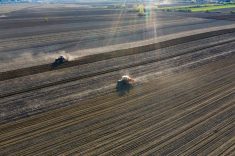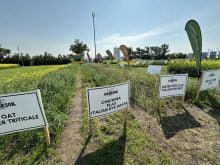Our grandfathers broke the rich prairie sod in the early 1900s. Even then, power and machinery were available to keep the soil free of weeds in the fallow year and pulverize the soil in the process. Serious wind erosion started soon after cultivation, but the “dirty thirties” are best known for land destruction that sent Prairie settlers packing up and heading north. Many discuss wind erosion as a problem of the 1930s.
But it did not end in 1939 and the photos here show that in spades. The photos come from 35 mm slides I have scanned at the University of Saskatchewan office in recent years and the photographer is often unknown. Many are taken by soil survey staff of the day in Saskatchewan.
Ditches full of blow dirt were common in spring in the 1940s and ’50s.
Read Also

Cancer agency reclassifies another herbicide ‘probably carcinogenic’
The WHO’s cancer research agency has now put atrazine, a herbicide well known to corn growers, in the same potential-hazard category where the agency put glyphosate.
Light land and heavy land: Wind erosion
It is well known that light (sandy) land is subject to blowing but so is heavy clay land. In winter, the clods slake down to sand size and are ready for a big blow in spring if the land is bare.

Medium texture (loam and clay loam) soils are less subject to blowing but beat them up enough with tillage and they too will blow. My Dundurn farm is hilly glacial till of loam texture. In the early days, the entire quarter was fenced, so cows could run in the fall. The east fence had a three-foot accumulation of good topsoil. I tore out the fence and with my trusty six-yard Crown Scraper, took all of that topsoil and dumped it on nearby eroded knolls to great yield advantage.
What about south of the U.S. border?
My dad always described a big May blow as “a lot of land changed hands today.” But many times, it moved much farther than the neighbours’ land.
The Dakotas suffered as much, maybe more, than we did. Google “David Franzen NDSU wind erosion.” That will bring up videos and other information by David Franzen, professor of soil science, North Dakota State University. He has even calculated the amount of phosphorous and other nutrients that were “gone with the wind.” He describes situations where Thick Black soils lost feet of topsoil.

Jodi DeJong-Hughes of the University of Minnesota has assembled a very good extension bulletin on wind erosion in the northern United States.
Keeners can Google “Jodi DeJong-Hughes reduce wind erosion” to bring up the excellent bulletin, “Reduce Wind Erosion for Long Term Productivity.” It has a map that shows where the worst erosion occurred. It was my pleasure to meet Jodi at Manitoba Soil Science Society meetings several years ago. She is also known for her good work on soil compaction.
The future: Get the message out
With the introduction of zero-till seeding and a crop rotation including a legume and an oilseed, soil erosion by wind is a thing of the past, particularly in the driest areas in Saskatchewan and Alberta. In the Red River clay soils in Manitoba, tillage is still used to some extent and wind erosion does occur. It also occurs after root crops like sugar beets in southern Alberta and potatoes in Manitoba.

Zero till became common when Saskatchewan farmers went into their workshops and designed openers that would put seed in the ground and leave the stubble of the previous crop standing — no “cover crop” required. By the 1990s, the seeders were starting to appear on the market and the adoption of zero till proceeded until now and is the normal practice.
The ag industry must work harder to get that message out to the rest of society. Our soils are healthy. The “cover crop” is the stubble of the previous crop and soil erosion by wind is a rare occurrence. May was the big month for wind erosion in bygone days. To see wind erosion today, I must get away from the farming area and come into an area of the city being prepared for housing construction.

Ramp up communication
Let us get better co-ordinated as farmers, farm organizations and research groups to let the consuming public know what really goes on “down on the farm” these days. Our soils are healthy. As long as crop returns are greater than cropping costs and our soils are stable or improving, we are sustainable. All the current buzzwords like soil health, sustainable, resilient, cover crops, etc., etc., need a serious rework to get in tune with reality.
It would also be great if our Prairie universities upped the communication game to let society know the truth.
So, there you have it. Ramp up the communication within the industry and sing the song to the consumer and those at the food retail level that live off of the consumer.















